- Why Customer Reviews Are Important On Amazon
- This should be taken into account in Amazon reviews
- Rating, title, text, images and videos
- Pseudonym
- Date and marketplace
- Indication for which variant the review was submitted
- Comments
- Amazon Badges
- Verified reviews vs. unverified reviews
- "Useful" Rating and "Top Reviews"
- Representation of the rating average (stars)
- Display of the evaluation average for product families
- Profile of an Amazon reviewer
- Calculation of the rating of a product
- Display reviews within Amazon
- Submit reviews (customer view)
- Current guidelines for sellers and vendors
- How to get positive Amazon reviews?
- Dealing with negative reviews
- Amazon Review Monitoring - Keep an eye on your reviews
Why Customer Reviews Are Important On Amazon
If we buy a product on the Internet, we can neither touch nor try out the object of desire. In addition, there is a lack of direct contact and trust with the seller, which customers in "classic" retail trade build up through personal, individual advice. Especially with the first purchase, a high level of trust in the seller and the product is required. Customer reviews help to build such trust. Particularly positive reviews enable you to stand out from the competition and increase your product sales.
That's why reviews are so important for the e-commerce giant Amazon. They not only improve or worsen the Amazon ranking of an Amazon product listing, but are also elementary for the purchase decision of the customers. For example, 65% of all respondents in a Bitkom study in January 2017 stated that they read the reviews before buying a product. This meant that customer reviews ended up ahead of price comparison sites and personal conversations with friends, family and colleagues. The study also found that four out of ten online shoppers (39%) have less confidence in offers and products that do not have product reviews. Almost as many buyers (38%) stated that the ratings of other buyers usually match their personal assessment of the item they bought. Therefore, for you as an Amazon seller, it is essential to
- gain as many positive evaluations as possible,
- achieve a high positive overall rating and at the same time
- receive as few negative evaluations as possible.
Free trial
Just register for a 14-day free trial and we will show you how our Amazon Seller Tool and Amazon Vendor Tool can help you monitor your marketing activities on a daily basis. Start your free trial now
This should be taken into account in Amazon reviews
Rating, title, text, images and videos
Amazon reviews are structured according to a simple scheme. First, the rating of a product is done. The reviewer gives a star rating from 1 to 5. In addition, reviewers have the possibility to give their rating a title and add text, pictures or videos. However, this is not a must. It is also possible to give only the rating.
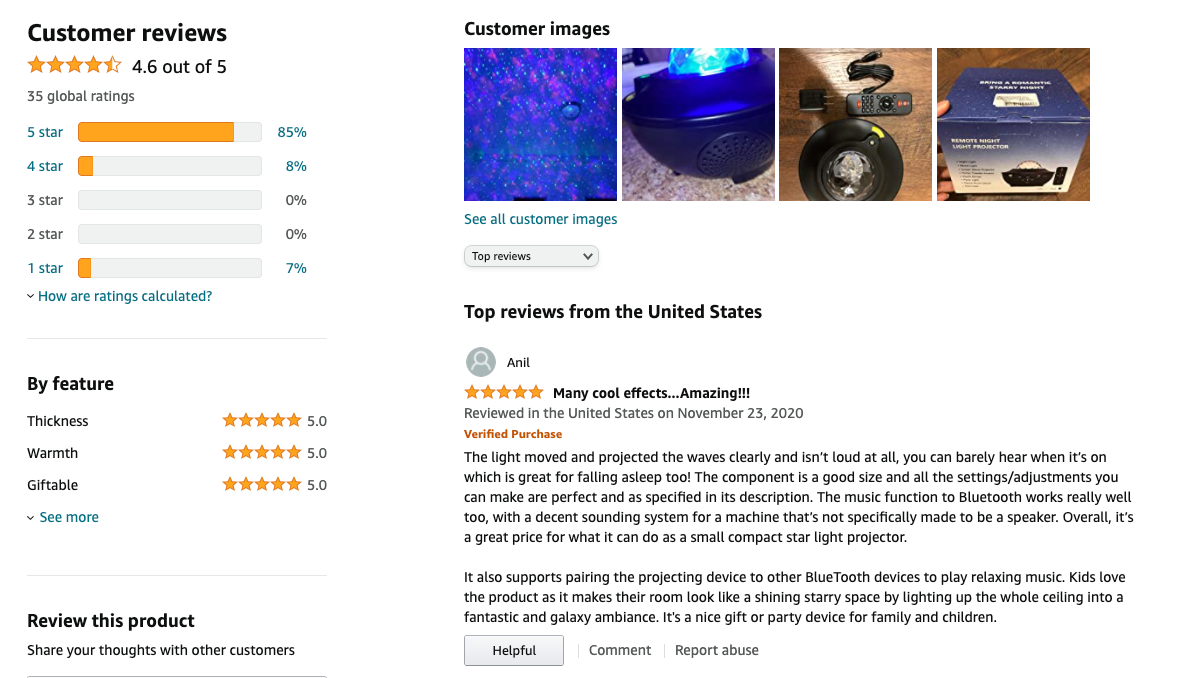
Pseudonym
When submitting a review, reviewers can give themselves a "nickname" (Image 2) to avoid any inference about the author of the review and his or her personal data. In addition, reviewers can also do without this pseudonym. In this case, the name of the author is "Amazon Customer" as shown in Figure 3.

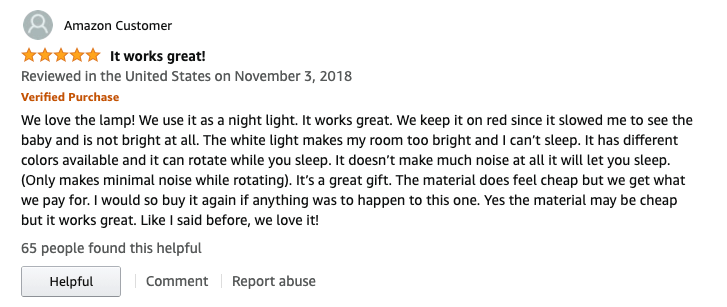
Date and marketplace
Potential buyers are shown when and for which marketplace the rating was given. Basically, the first reviews displayed are those in the language of the marketplace on which the buyer is currently located. This means that if a buyer is on the American marketplace (amazon.com), the reviews of buyers from the American marketplace will be displayed first. Only later are the international reviews of the other marketplaces (e.g. amazon.de) displayed. By selecting the option "Latest first", the reviews can be sorted by topicality. The date is always the time of writing and not the time of publication.
Indication for which variant the review was submitted
In the case of families of variants, it is indicated for which variant of the article a rating has been given. If, for example, the Gold color variant of the MacBook Pro 13 with a capacity of 256 GB was rated, this information is also found in the review:
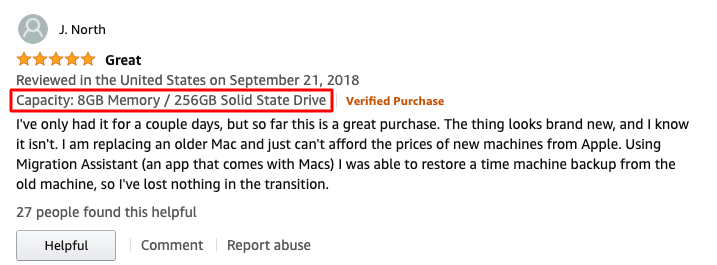
Comments
By clicking on the grey comment link, comments can be made on individual reviews (Figure 6). Thus, both end users and Amazon sellers can comment on a review. However, the product detail page does not show how many comments have already been made. Only after clicking on the comment link will you be redirected to a page (Figure 7) where you can see how many comments have already been made on this review. If you click on the blue comment link again, all comments are displayed (Figure 8).
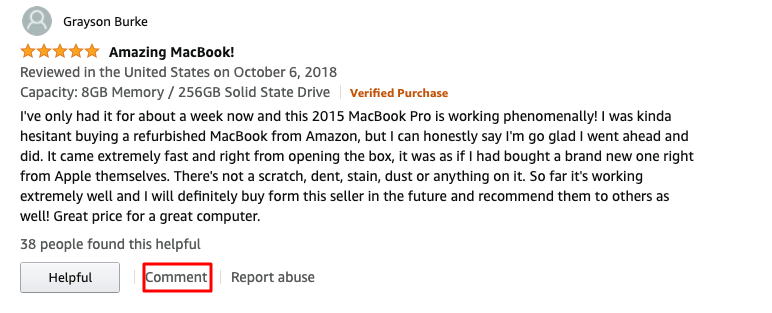

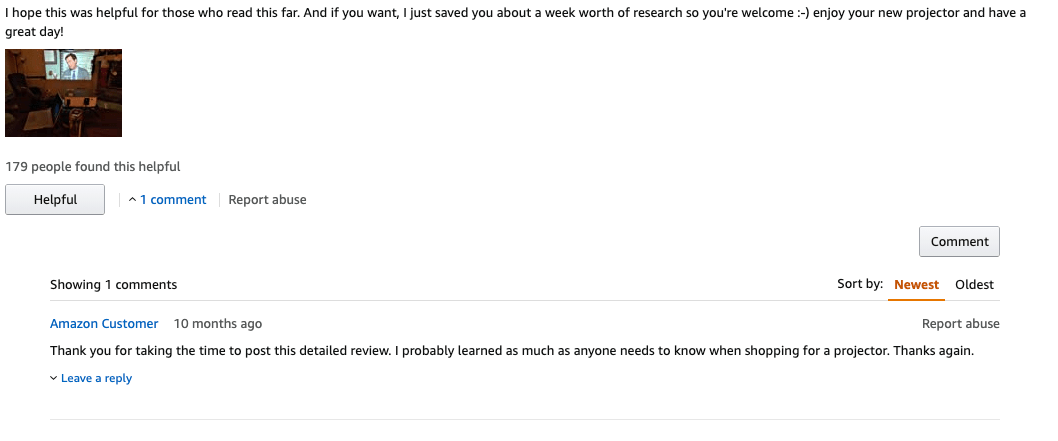
Amazon Badges
As an Amazon reviewer you can get so-called Amazon Badges by writing helpful articles on Amazon. Some of these badges appear only occasionally. In addition, the appearance of some Amazon Badges varies depending on where they are displayed. They can appear under the user's name as well as before the review. The following table gives an overview of the different badge types including their meanings:
| Designation | Description |
|---|---|
| Leading Reviewer, Top-10/50/100/500/1000 Reviewer, Hall-of-Fame Reviewer | These badges denote top reviewers. The top reviewer ranks show the current best reviewers, while the Hall-of-Fame indicates those who have reached the top of the ranking in recent years. |
| Top Contributor | This badge is awarded by Amazon to customers who regularly give reviews or answers to areas of interest that other customers find helpful or interesting and for which they are most enthusiastic. |
| Amazon Verified Profile | This badge indicates that the identity of this contributor has been verified by Amazon. |
| In Person | This badge indicates that the person who received it is the celebrity "in person" that most people associate with this real name. For example, if you see "In Person" under the name of Roger Federer in one of his reviews, you know that this review was actually written by the celebrity tennis player. This is a permanent badge. |
| Amazon Official | This is an official Amazon employee. This is also a permanent badge. |
| Author, Artist, Manufacturer | These badges are awarded to verified representatives of items offered at Amazon, for example, the author, artist or manufacturer of a product. |
| Vine Voice | This customer is an Amazon Vine Product Tester. Amazon Vine is a program to which reviewers are invited who are most trustworthy from Amazon's point of view. These reviewers are given access in advance to articles that are not yet on the market to give their opinion. |
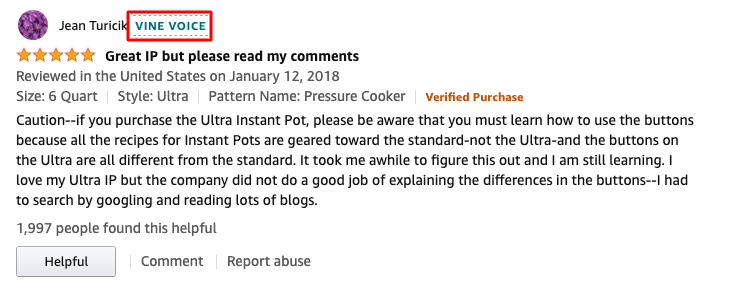
Verified reviews vs. unverified reviews
Amazon distinguishes between "verified" and "non-verified" reviews of products. If a customer has purchased a product on Amazon, his or her review is displayed as a "Verified Purchase" (Figure 10). This allows everyone to see that this reviewer has actually purchased the product. However, since Amazon would like to collect as many reviews as possible on its platform, reviews can - within a limited scope - also be submitted without having made a purchase.
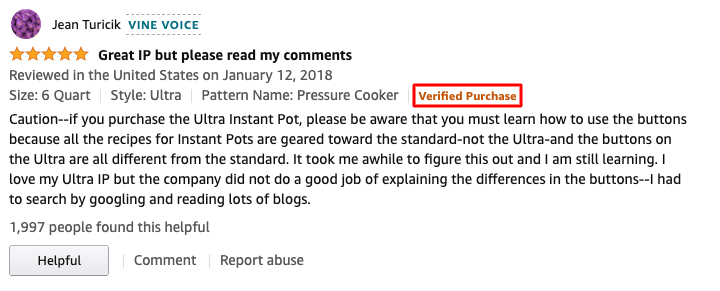
If a customer has made a purchase with a voucher, it is possible that Amazon will not consider this a "verified purchase" in a review following the purchase. This depends on the amount of the voucher. Amazon thus pursues the goal of counteracting possible trickery, which generates verified reviews with incentive-based systems. In other words: Amazon sellers provide customers with free vouchers so that they can purchase their products and then submit a verified review. We will discuss the dangers of rating manipulation and the topic of fake ratings in more detail later.
"Useful" Rating and "Top Reviews"
Below each rating there is the possibility to rate the review as "Useful". The more customers have found a review useful, the higher up it is displayed. If numerous users have rated a review as useful, it will belong to the Amazon "top reviews". If you select the "Top reviews" display instead of "Newest first", the most useful reviews for the respective product are displayed in descending order.
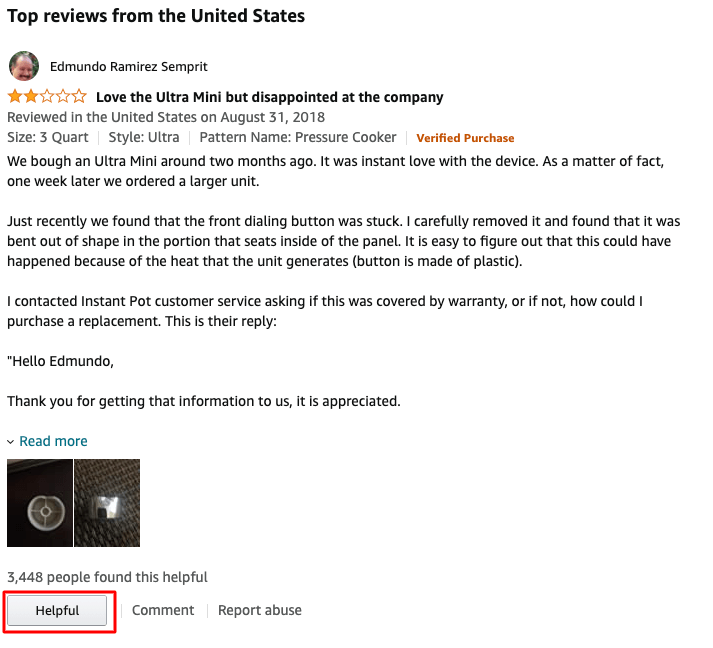
Representation of the rating average (stars)
An important aid for the purchase decision of potential customers is the rating average of all star ratings given.
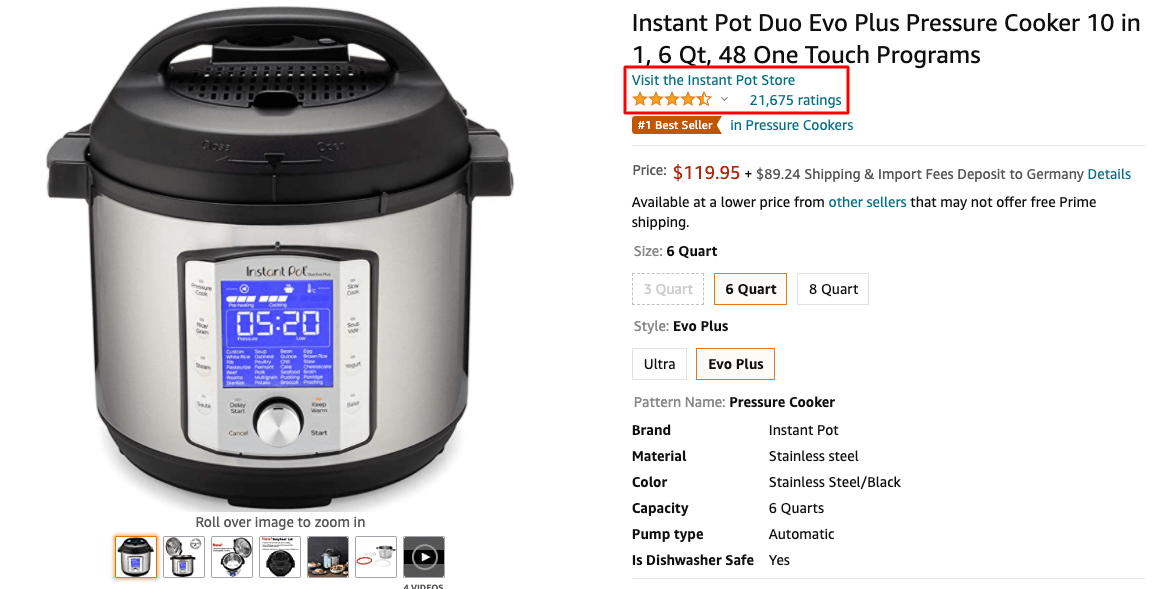
The Amazon star overview is displayed in the search, in the advertisements as well as on the product detail page under the Amazon product title. This display forms an average of the reviews submitted for the product, calculated by Amazon. We will discuss the calculation of the average later. At Amazon, a star is always only displayed completely filled in, half filled in or not filled in.
A representation of the rating distribution can be found further down on the product page. Here you can see how the share of the different star ratings is distributed. In the past, the number of individual star ratings was given, but now they are percentage values.
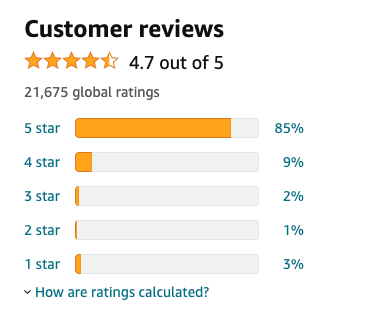
Display of the evaluation average for product families
Currently, all products within a product family share the reviews and the rating average. This means that Amazon adds up the reviews for a variant family. For example, if a variant family with two child products has 5 reviews on Child A and 15 reviews on Child B, 20 total reviews are displayed for each child in the search, in the campaigns or on the detail page.
Meanwhile, however, it occurs again and again that Amazon separates the reviews for variant families. In this case, reviews are only displayed for each individual child. For our example, this means: For Child A only 5 reviews and for Child B only 15 reviews are shown.
It is not quite clear by which logic Amazon makes this division. Nevertheless, for you as a seller, it is clear that each product variant requires its own reviews. Merging products into product families or adding child products to already existing families in order to "pull along" a product with few or below-average reviews will no longer be a solution in the long run. Amazon wants to prevent exactly this method to create more transparency for the customers on the marketplace.
Profile of an Amazon reviewer
By clicking on the name of a reviewer, you can access their profile. The profiles of reviewers are public on Amazon. Here you can get information e.g. about the reviewer's rank reviewer's rank and see which badges the reviewer has received. In addition, you can find out how many reviews this reviewer has given in total and how often these reviews have been rated as useful by other users. Last but not least, all previous community activities of the reviewer can be viewed.

Calculation of the rating of a product
In the past, the star chart depicted the simple average (mean value) of all reviews. This is no longer the case today, as the weighting of the individual reviews has been adjusted by Amazon. Amazon does not explain how exactly the current ratio is calculated. It merely points out that the star ratings are calculated using machine learning models. According to Amazon these models take various factors into account, such as whether the rating is up-to-date or whether the purchase is verified. Furthermore, criteria are used to determine the authenticity of the feedback. According to Amazon, this system improves continuously over time.
For an indication that more recent ratings have a higher weighting, see Figure 15. In this example, the 1-star rating is more significant than the 5-star rating. If we look at the date of publication, we can see that the 1-star rating is more recent than the 5-star rating. Therefore, you should make sure not only to achieve a high number of positive reviews, but also to receive them regularly.
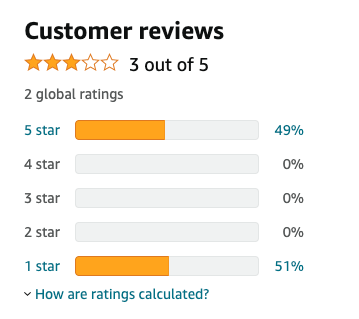
Display reviews within Amazon
Product detail page
On the product detail page, the star rating above-the-fold is displayed directly below the product title.
Where does the term "above-the-fold" come from?
The term "above the fold" finds its origin in the newspaper sector. Here, this term describes the part of the newspaper, which can be seen above the fold and is thus visible at first glance.
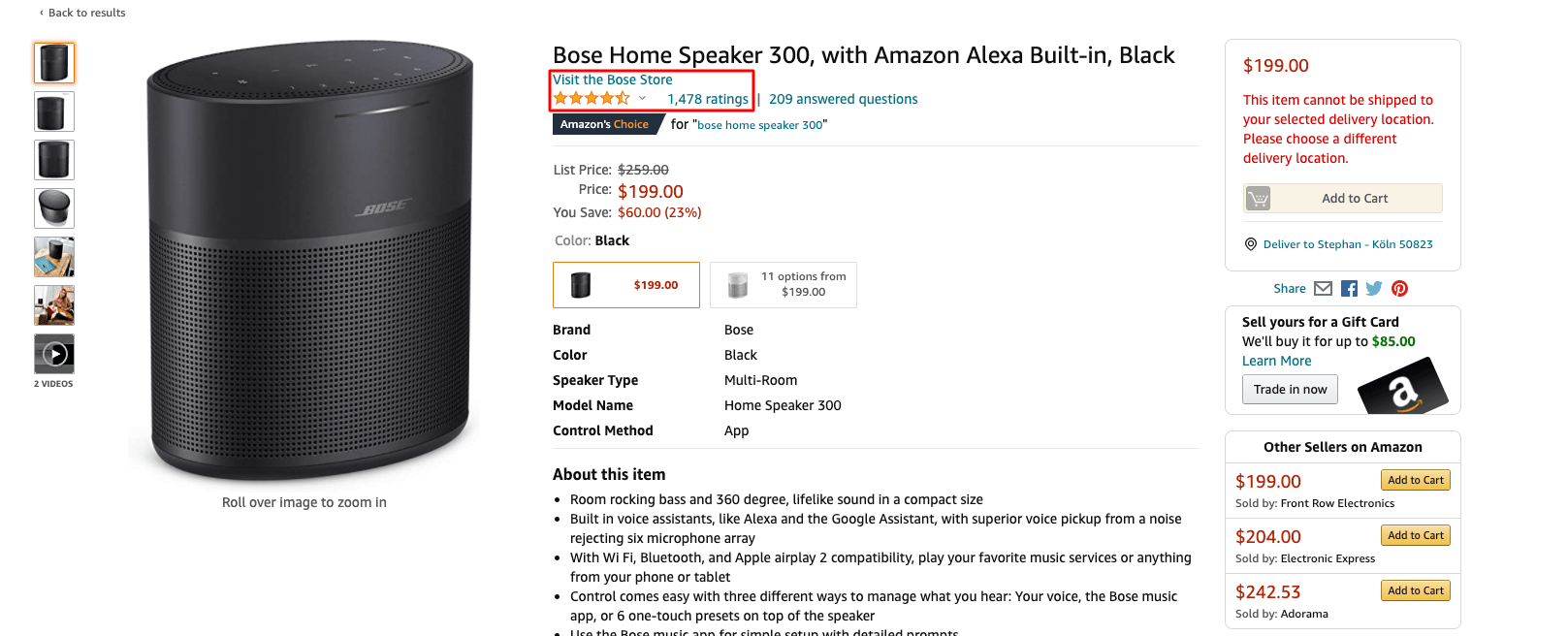
If users scroll further down, they will get to the "below-the-fold" area. Here some national and international top reviews are displayed. In addition, the reviews can be sorted by "Newest first" using a drop-down field:
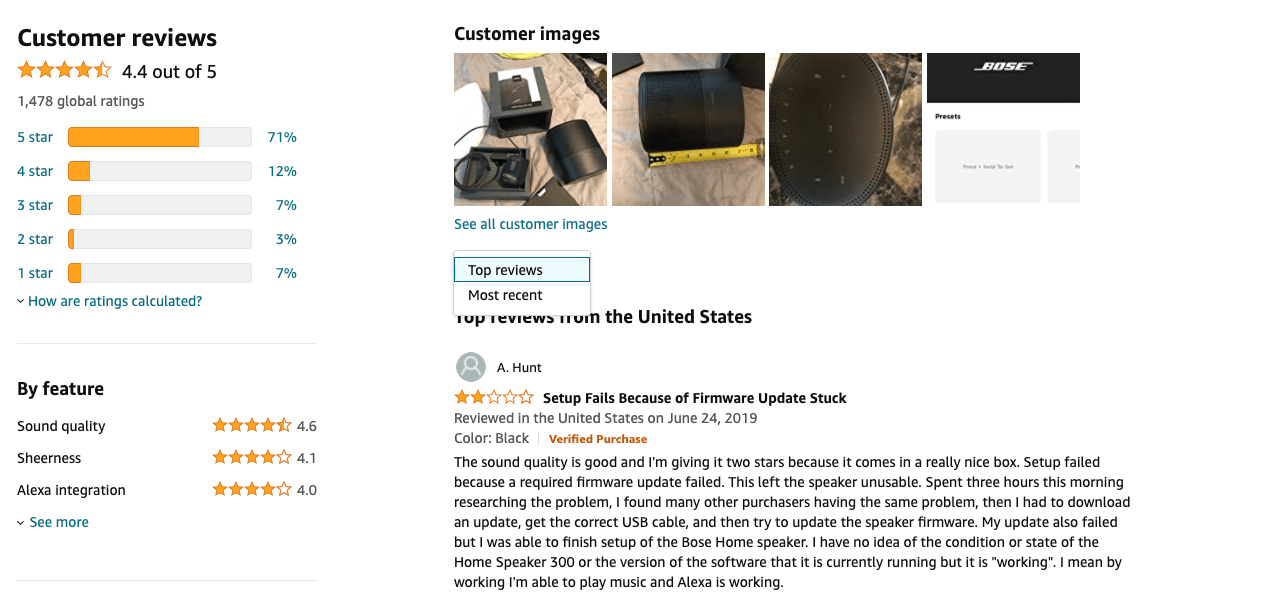
Above the reviews the customer pictures are displayed. Here all pictures are collected, which were uploaded by customers in the context of the reviews. Below the customer pictures, keywords are displayed which are used again and again within the reviews of a certain product. This allows users to search for reviews more specifically.
Reviews page of an item
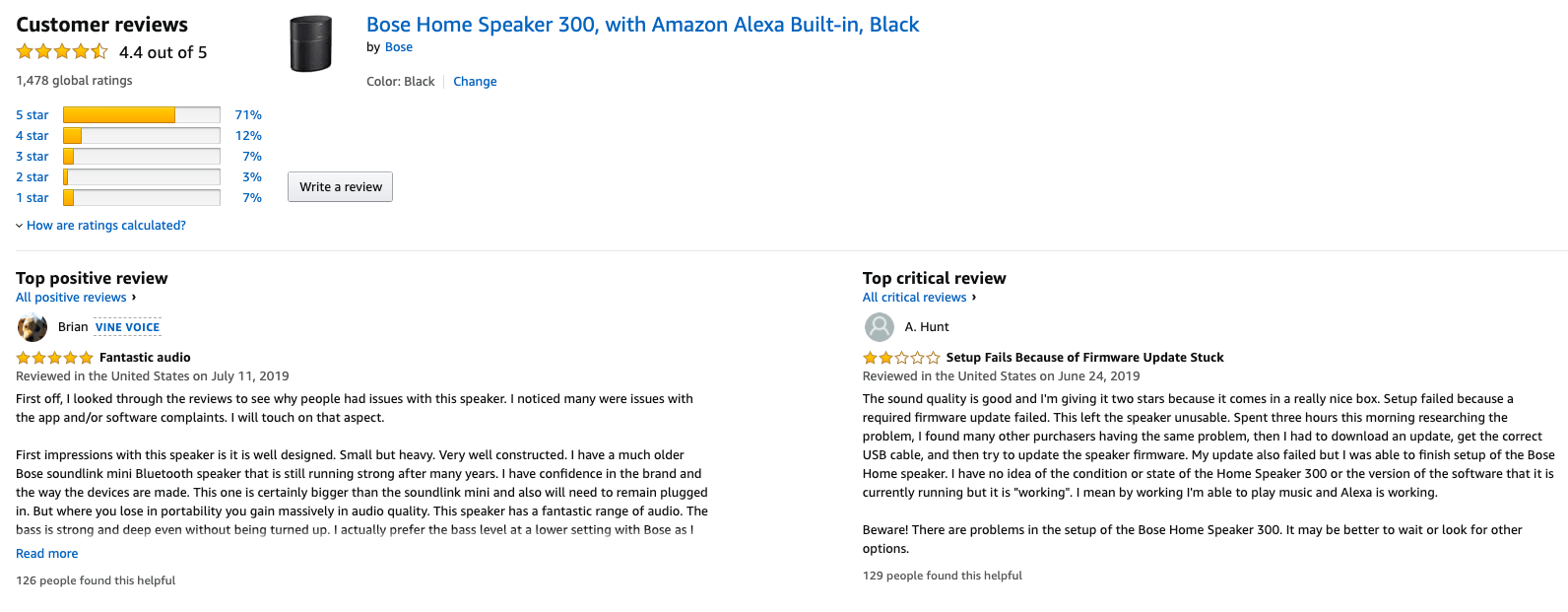
On the reviews page of a product, users have the possibility to filter and sort the reviews according to different criteria. Furthermore, questions can be asked and comments can be added to the reviews. The first thing you can see on this page is the complete overview of the star ratings. Below this, the highest rated positive review and the highest rated negative review are displayed side by side. Under the two headings the total number of positive and negative ("critical") reviews can be read. With a click on the respective blue field, you can display the total number of positive or negative reviews. If you scroll down further, a search field is available to the user, with which he can search for specific ratings. In addition, the reviews can be filtered according to the type of reviewer, number of stars, format and media usage as well as sorted by topicality or "Highest rated":
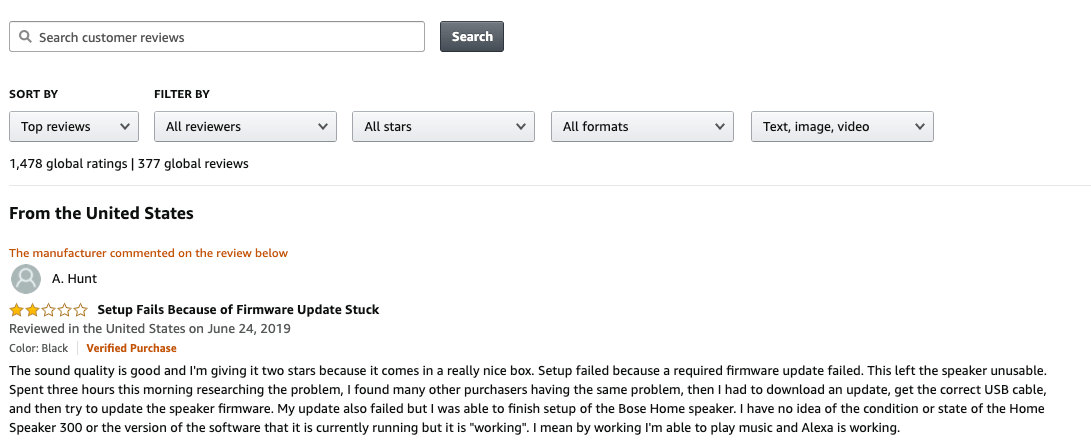
Submit reviews (customer view)
Where is the notice that a review can be submitted?
Amazon would like to encourage as many users as possible to submit a review. Therefore, the e-commerce giant informs its users about this possibility in many places.
A first hint is given in the users' order overview. Thus, a call-to-action with the request "Write a product review" is displayed to the right of the respective product:

The submission of Amazon quick ratings
Based on the list of their last purchases, users can rate their purchased products. Amazon simplifies this process by providing "quick ratings". Since most buyers do not want to spend unnecessary time submitting a review, the review should be as quick and easy as possible: Stars can be awarded with just one click. If you want to, you can of course still submit a detailed rating, for example with photos and text. With this uncomplicated way of rating, Amazon is able to generate the first ratings of new products at an early stage and thus quickly increase the number of customer reviews.
A further hint for giving ratings can be found on the product detail page. If you scroll down to the customer reviews, you will find the button for writing a customer review on the left side:
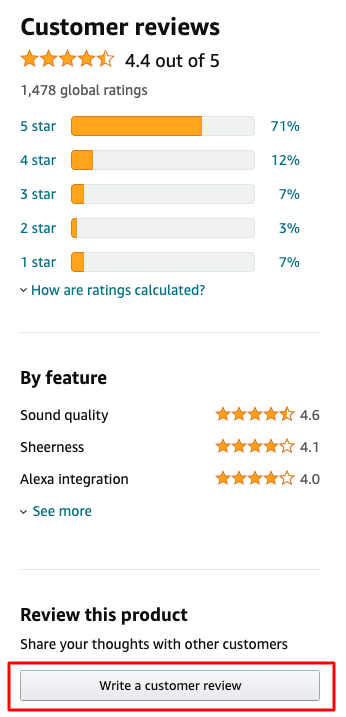
In the following image you can see another Call-to-Action for review submission. If a user is on the review page of a product, he can also submit a product review here by clicking the "Write review" button. This is displayed above-the-fold directly next to the star overview:

How are standard reviews delivered?
In a "standard review" the buyer is asked to give an overall rating based on stars, a review title and a descriptive text. In the case of more complex products, product characteristics are also increasingly in demand. Figure 22 shows that for headphones, for example, the customer's opinion on sound quality, comfort and Bluetooth connection is also queried:
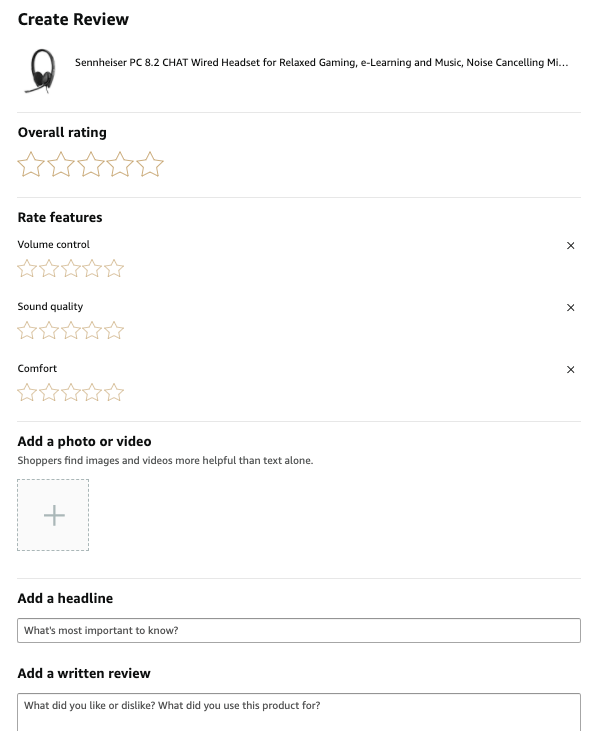
If a customer has written a review, it is not immediately published on the product detail page of the respective article. The fact that the publication of the review takes a few days suggests that Amazon checks it beforehand. After publication of the review, however, the review date does not show the date of publication, but the time at which the review was written and submitted by the customer.
How can a customer view, change or delete his review?
If a customer has changed his mind and he wants to view, change or delete his reviews, he can do so in his profile:
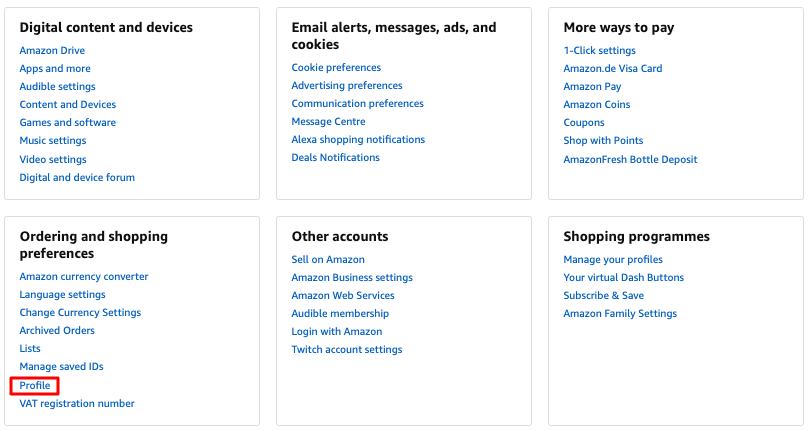
Once in his profile, the user can now view his community activities and edit, delete or hide them in his profile. For you as a seller it is advantageous that Amazon users can change or delete their reviews afterwards. This gives you the opportunity to satisfy an initially dissatisfied customer with good customer service and the customer changes his negative rating into a positive one.
Current guidelines for sellers and vendors
Amazon places great value on enabling and preserving an authentic shopping experience for its customers in compliance with all rules. Therefore, you should regularly keep an eye on the Guidelines for creating customer reviews. Non-compliance with the guidelines can, in the worst case, even lead to deletion of your merchant account. For this reason, the following section explains what is currently allowed and what is prohibited.
To create customer reviews or customer responses, you must have purchased items from your Amazon account for at least 50 EUR within the last 12 months. This does not include the use of promotion vouchers.
With this regulation Amazon wants to limit the circle of people who are allowed to write a review. If in the past a never used Amazon account was sufficient, now a purchase over 50€ must have been made within the last 12 months in the marketplace where the review is to appear.
Ratio of verified to non-verified reviews
According to current guidelines, Amazon limits the amount of reviews based on "unverified purchases". While reviewers can still rate products they have not purchased, only five "non-verified" reviews can be posted per week. If a product receives an unusually large number of "non-verified" reviews in a short period of time, Amazon reserves the right to only allow "verified" reviews for that item.
Accordingly, the ratio of verified to non-verified reviews is constantly monitored by Amazon. However, the regulation is not entirely clear and is constantly adjusted. If for some products, which have not yet received a rating, two to five non-verified ratings can still be given without restriction, then for products which already have verified reviews, the proportion of verified reviews within a certain period of time must be higher than that of non-verified reviews. As a rule of thumb, a currently verified review can also be submitted as an unverified review. In principle, however, Amazon reserves the right to impose restrictions as soon as irregularities are identified:
We reserve the right to limit the possibility of publishing a review if we discover unusual reviews or to preserve the best possible shopping experience.
Prohibition of reviews from the immediate environment
Clearly inadmissible are reviews that you have created as Amazon Seller or Amazon Vendor yourself. In addition, reviews generated by the seller's immediate environment are prohibited. This includes relatives, close friends, business partners or employees.
Prohibition of manipulation of "useful" reviews
The same applies to the "useful" evaluations already mentioned. Amazon wants to avoid that you as a seller can influence the placement of the reviews. If this prohibition did not exist, you could, for example, help your positive reviews to a higher position through a high number of consciously marked "useful" ratings and thus bring them to the fore for potential customers. In the same way, you could mark unpleasant, negative reviews as "not useful" and thus move them out of the field of vision of potential customers.
Ban on incentive-based reviews
A further restriction applies to incentive-based valuations. Thus Amazon specifies this prohibition in the following wording:
A seller offers a third party a financial reward, discounts or other compensation for a review of his product or a competitor's product. This includes services that sell customer reviews, and websites or social media groups with implicit or explicit agreements or expectations that there is an incentive when customers leave a review.
Illegal, incentive-based reviews include all reviews that are generated because the reviewer receives a direct or indirect consideration from the seller. Consideration includes free or discounted products, money, vouchers or participation in a competition. The only exception is Amazon's own review program Amazon Vine (more about this later). Furthermore, it is forbidden to place a post in a Facebook group, for example, and to ask for a rating for your product.
Amazon has once again clarified the Guidelines for inadmissible product reviews by customers with examples:
- A salesperson writes a review of a competing product.
- A seller offers a quid pro quo for a review of his own or a competitor's product. This includes services that sell reviews or social media groups.
- A seller offers to (partially) refund the purchase price after a review has been submitted.
- For example, a seller uses a review club that offers free or discounted products.
- Reviews from the seller's financial or personal environment (employees, close friends, family, manufacturer, third party suppliers of the product).
- A seller offers a refund for deleting or changing a negative review.
- A seller manipulates the "useful" or "not useful" ratings in reviews of a competitor's items.
Amazon also imposes clear limits on the content of reviews:
- Reviews must be respectful, i.e. threatening, insulting, obscene, harassing, intolerant, racist content is prohibited.
- Reviews may not contain advertising, including URLs with referrer tags or affiliate codes.
- Sexually explicit images and descriptions in reviews are not allowed.
- Reviews may not contain content that advocates or supports illegal behavior, such as violence, fraud or illegal drug use.
If a review is removed or rejected by Amazon once because it contradicts the guidelines, the reviewer is not allowed to submit another review on the same product, even if it has different content.
How to get positive Amazon reviews?
As a seller, you are faced with a chicken and egg problem. A product without reviews is rarely or never bought. A product that is bought only rarely or not at all will not receive any reviews. In addition, customers who are satisfied with a product show little willingness to give a positive review. In contrast to this, buyers who are dissatisfied with a product are more willing to place a negative rating in order to "warn" other potential buyers about the product or the seller.
This raises the question of what options are available to you as a seller to break through this dilemma. To give you a comprehensive overview, we will show you a few practical methods which are against the Amazon guidelines, but whose application can be observed again and again. We would like to emphasize that we clearly advise against the use of these tactics.
Unlawful but in practice observed methods
Ask customers for an evaluation in a separate e-mail
Basically, Amazon points out that after the purchase and receipt of a product, an e-mail is automatically sent in which the buyer is asked to give a product evaluation. Therefore, it is not necessary for you as a seller to take further measures on your own initiative.
Nevertheless, there are sellers who automatically send an e-mail to the address provided by Amazon after a purchase with the request to leave a review. This procedure is not advisable, as it can be argued that a request for an evaluation is an unreasonable nuisance according to § 7 UWG (German Law). However, when collecting and using his address, the customer must be clearly informed that he can object to the collection and use at any time. If you use the e-mail address of a customer without his consent, you run the risk of being warned.
Amazon itself writes about this in its guidelines:
Unsolicited e-mails to Amazon customers (unless necessary for shipping and appropriate customer service) and marketing related e-mails of any kind are prohibited.
In addition, Amazon has included an opt-out button in every email you send to a customer. This allows the customer to unsubscribe from unwanted e-mails at any time. Since Amazon may include this value in the sales performance in the future, you should consider carefully which e-mails you send during the purchase process.
The invoice as a "Trojan horse"
Some sellers try to circumvent this ban when sending invoices. For example, an evaluation is requested in the invoice e-mail or directly on the invoice itself. However, even here it is not clearly defined whether this way is legally clean. Therefore, one is currently at least in a grey zone.
Call customers and ask for evaluation
In the case of Amazon FBM ("Amazon Fulfillment by Merchant"), the seller's own shipping, the buyer's phone number is provided in the order report. In the past, some Amazon vendors have used this feature to call the customer on the pretext of asking for their satisfaction. This method is also prohibited by Amazon, as can be seen in the Seller Guidelines on Prohibited Actions and Sales Activities:
Never use the customer's phone number to contact them. Only use the buyer-seller mailbox to contact the customer regarding his order.
The current legal situation also prohibits direct telephone contact with the customer:
Unreasonable harassment is always to be assumed ... in the case of advertising with a telephone call to a consumer without his prior express consent or to another market participant without his at least presumed consent ..." (§ 7 paragraph 2 sentence 2 UWG).
Supplement in the package/with the product
On the Internet it is often recommended to send parcel enclosures. However, these are not welcomed by Amazon. So Amazon writes under "What you should avoid":
attachment of marketing information or advertising material to the packaging material.
Although it is unclear whether this is a ban or merely a recommendation on the part of Amazon and what consequences a violation would have, it is not clear. However, Amazon recently emphasized that this method is generally regarded as very critical and one should not "prescribe" to a customer that he should only evaluate if he is satisfied.
Nevertheless, the use of parcel enclosures can be an effective means of generating customer ratings. In the following image you can see a nice example of the brand "Anker" how a customer service can be successfully implemented down to the last touchpoint:
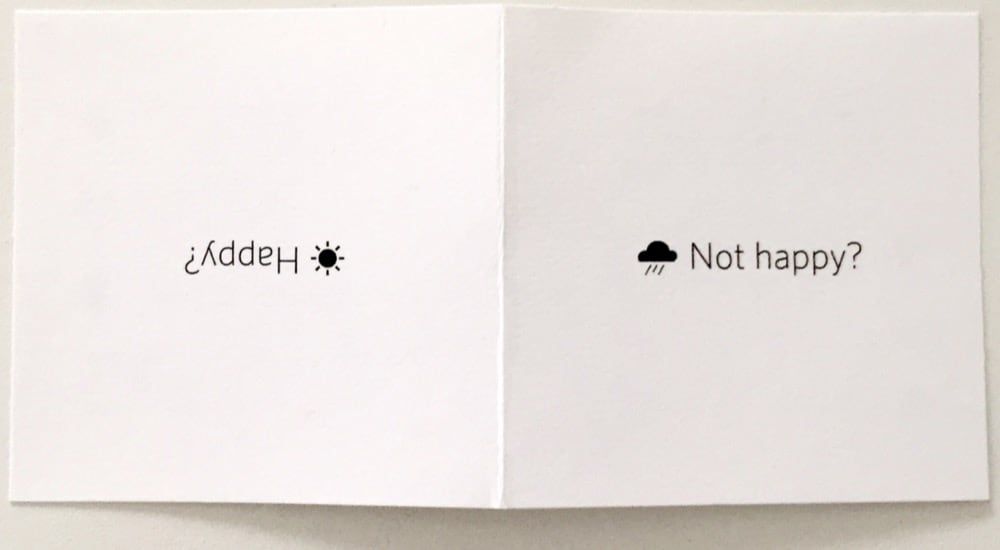
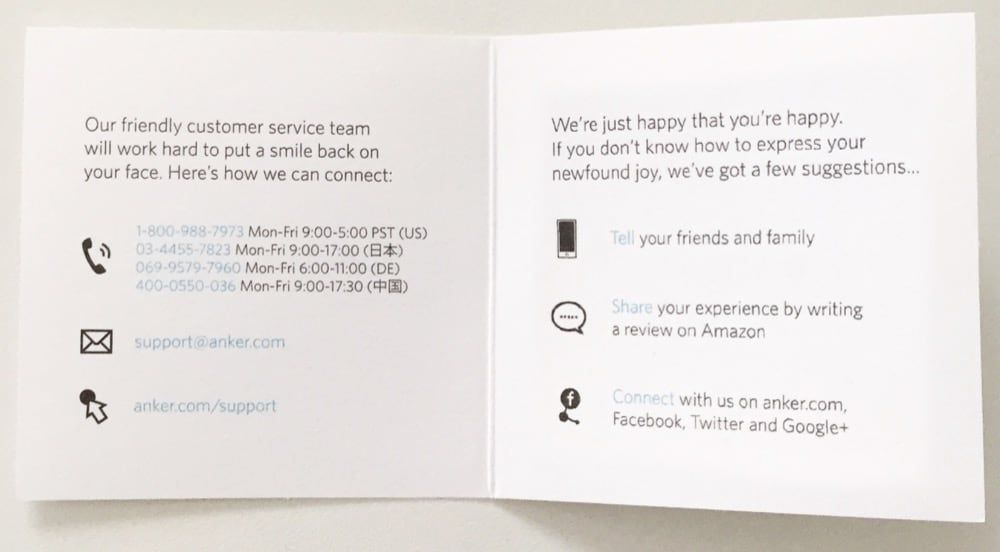
Through the package insert, customers are clearly invited to contact us and complain if they are not satisfied with their purchase. This offer alone often takes the wind out of the sails and helps to counteract negative product reviews from the beginning. Thus Anker puts customer service clearly in the foreground and gives "by the way" the hint to be happy about a positive evaluation. The direct indication of contact details in the form of telephone numbers and e-mail addresses also shows a high degree of self-confidence on the part of the brand and thus underlines its intention to satisfy its customers in the best possible way.
Use of product tester groups
On some social platforms there are groups whose members offer themselves as Amazon product testers and can get in contact with Amazon sellers.
This action alone is already enough to violate Amazon's guidelines. Because on the one hand, the seller can thus control the selection of product testers. On the other hand, he already tries to influence in his mail what kind of rating should be given.
If seller and user can agree, the next step is to agree that the selected product tester will purchase the product from Amazon and give a 5 star review as a verified seller. Afterwards, the seller will refund the purchase price. This transaction represents another violation of Amazon's guidelines, as the buyer has been paid an improper consideration.
Use of review services
The generation of product evaluations has now developed into a business area in its own right. Numerous companies offer customer reviews for sale by referring the companies' orders to private individuals. It is not only controversial whether the generated reviews actually reflect the honest opinion of the reviewers. It is also often unclear whether the reviewers have actually tested the product or whether they have just given a complimentary review. According to the Amazon guidelines, services that sell customer reviews are clearly defined as improper activities.
However, these methods not only violate Amazon policies. A judgement of the Munich Regional Court decided in November 2019 that purchased fake reviews on the Internet are illegal. The court thus upheld a lawsuit filed by the vacation portal Holidaycheck against the provider Fivestar Marketing. According to the court, fake ratings also pose a major problem outside of Amazon. In 2018, Amazon alone spent around 400 million US dollars to put a stop to fake reviews.
Therefore, you should consider carefully whether you decide to work with an external service provider to generate ratings. The risk that your reviews will be deleted, your Amazon product listing will be blocked, your seller account will be deleted or you even have to fear legal consequences is high.
Amazon Vine - Club of product testers
A perfect method to generate reviews is Amazon's own review service Amazon Vine. Here, both Amazon sellers and Amazon vendors can order product reviews for a corresponding fee.
As soon as a seller has approved a number of products for a product review, Amazon offers the vine testers these products for testing via a special newsletter. In a next step, vine testers can then select the products they want to test and receive them free of charge. The tester then reviews the product and writes a review within 30 days. This review is marked under the product with a corresponding badge as "Vine-Review".
To become a Vine product tester, you have to be invited by Amazon. Amazon evaluates potential candidates according to various criteria, such as their reviewers rank or their interest in a certain type of product. Vine members do not receive payment for their participation in the program, but may keep the tested products afterwards. As a seller, you cannot directly contact the testers and therefore cannot influence the reviews of Vine members.
Amazon Early Reviewer Program
In addition to the Amazon Vine Program there is the so-called Early Reviewer Program especially for the US and UK marketplaces. In order for an Amazon Product Listing to participate in this program, it must be listed on amazon.us or amazon.co.uk, have less than 5 reviews and its price must be higher than $15.
The program is designed to encourage customers to share their experiences and thus generate early reviews for products that have few or no reviews. When customers submit their reviews within a certain period of time, they will receive a small reward, such as an Amazon gift card worth $1-$3, and the review will be marked with an Amazon badge as an early review.
With this program Amazon wants to offer sellers another possibility to generate reviews for new products. On the other hand, it is intended to reduce the use of unauthorized methods such as spam mails and thus protect the customers more effectively. When and to what extent the Early Reviewer Program will also be introduced in Germany is not yet certain.
What happens if I manipulate reviews?
If you manipulate reviews, you run the risk of permanently damaging the reputation of your brand. In addition, Amazon is taking increasingly harsher sanctions against fake reviews.
Reviews that do not comply with the guidelines will be deleted by Amazon. If a product shows a conspicuous review pattern, the product listing is checked and blocked if a rating manipulation is accepted.
If fake reviews are increasingly associated with a particular seller, this could lead to the deletion of the seller account. In this case the seller will not be able to open a new account either.
In addition, the US group also takes legal action against fake reviews. In March 2019, for example, Amazon won a landmark decision at the Frankfurt Higher Regional Court, according to which purchased reviews must be marked as such from now on. In its Guidelines the Group also points out legal consequences. Here it says:
A violation of our policies may also be a violation of applicable laws, which may result in legal action and civil and criminal penalties.
How do I recognize Amazon Fake reviews?
Often fake reviews are not immediately recognizable at first glance. However, there are a few conspicuous features you should be aware of:
Building up numerous reviews in a very short time
A product generates a high number of 5-star ratings within a very short time. This is particularly noticeable with product launches. If a product has an unusually high number of reviews shortly after its market launch, it is suspected that the sales launch was pushed by manipulated reviews.
Very long and too detailed reviews
As a rule, dissatisfied customers tend to give long reviews. Satisfied customers usually keep their reviews short. Detailed and rambling explanations about the advantages of the product in connection with innumerable application examples and pictures, speak for the fact that the evaluation was bought.
Advertising phrases
Customers usually use a colloquial tone and not typical advertising phrases. The use of superlatives and exclusively positive adjectives could be an indication that this has been remedied. Product names are also usually not written out in full or mentioned several times by customers.
Reviewer profiles
If a reviewer only writes a high number of 5-star reviews on a specific topic, these could also be paid reviews. Furthermore, it is suspicious if the same review text is given over and over again.
Chinese Amazon sellers in particular use various tricks to create artificial reviews - so-called Amazon Fake Reviews. We have written a separate article about this, in which we show you examples for the construction of fake reviews. You can access the article by clicking on this link.
Dealing with negative reviews
How can I avoid negative reviews?
Sale of a flawless product
Sounds simple, but it's like this: The best way to avoid negative reviews is to sell a flawless product. The more customer needs your product meets, the more satisfied your customers will be and the fewer negative reviews you will receive.
The product delivers what it promises
The expectations of the customers should be fulfilled. Accordingly, you should avoid building up "castles in the air" in your product description and promise added value, which you ultimately cannot fulfill. If you truthfully name the product features, the associated benefits and the correct use of the product, you will raise realistic expectations among your customers. If product description and reality differ too much from each other, some buyers may feel deceived:

Comment on negative reviews
Many sellers make the mistake of leaving a negative evaluation and not commenting. This leaves the customer with his negative experience. Experience shows that this encourages other reviewers to discharge their frustration - justified or not - in their comments. In any case, you should always comment on a negative review and try to address the customer's problem. Even if the problem cannot be solved or the review is unjustified, you are sending out a signal that the needs of your customers are important to you. As a result, future potential buyers see that the seller cares about his customers, which significantly reduces the willingness of customers to give a negative review.
Punctual and flawless delivery
Late or damaged deliveries can also lead to bad ratings. Shipping and packaging are part of the shopping experience and are included by the customer in the evaluation of a product. If you are a seller using Amazon FBM for shipping, you should not raise false expectations about the shipping time and choose a realistic timeframe.
Proper returns processing
If the product does not meet the expectations or is damaged, the customer has the right to return the product and receive a refund. Also in this case you should not be negligent in the handling of the return process and show yourself from your best side, because this point is not insignificant in the evaluation.
Good customer service
Give your customers the feeling that you care about their needs and want to solve their problems. The possibility of direct contact and prompt dealer feedback play a decisive role in this. If possible, you should avoid letting your customers' inquiries "go to waste". The customer is king. There is no other e-commerce platform where this saying plays a greater role than on Amazon. With exemplary customer service, you can still save some reviews.
What action can I take in case of negative reviews?
If you have received a negative review despite all efforts, there are several ways to deal with a negative review.
Comment publicly
As recommended in the previous chapter, you should definitely comment any negative review publicly. This will give you the opportunity to respond to the complaint and present your point of view. You can explain what you will do or have done to solve the problem and thus put the criticism into perspective. In addition, you can use this way to ask the reviewer to contact you if this has not been possible so far, so that we can jointly resolve the problem.
Image below shows the example of an Amazon seller who has commented on a review in a friendly and objective style. In this review, he first apologizes for the circumstances, offers the buyer a refund and asks him to contact the seller directly to clarify the problem personally:
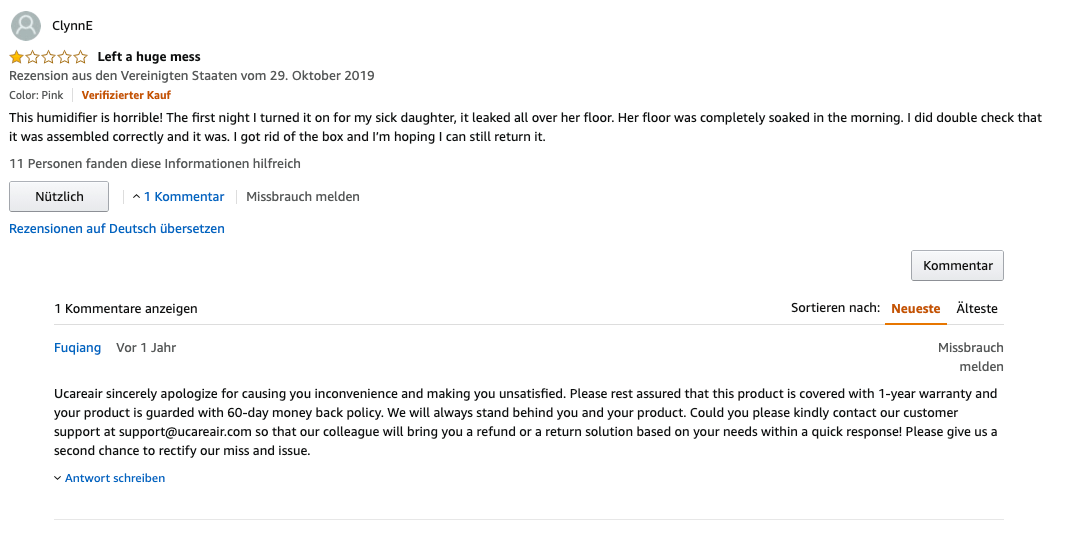
Correction or deletion by customers
In the best case, public commenting can lead to the customer correcting his negative review, changing his entry to a more positive review afterwards or deleting the negative review from the buyer.
Deletion by Amazon
If a review violates the Amazon Community Guidelines, you can try to have Amazon delete it. However, such a violation only occurs in extreme cases such as fraudulent, insulting or linguistically inappropriate reviews. An unfair review does not constitute a reason for removal by Amazon. To initiate Amazon's review of a review, all you have to do is report it as abusive with a few clicks and a brief reason.
When can I still save a product listing with numerous negative reviews and when should I delete it?
Whether an Amazon product listing can still be saved is always a decision made on a case-by-case basis. Extremely serious, negative reviews can have a devastating effect. When deciding for or against removing a product listing, you should always take into account that you will lose all positive reviews that you may have worked hard for over a longer period of time.
How do I know if a competitor wants to harm me and deliberately places negative reviews under my product listing?
If negative reviews accumulate under your product within a short period of time, which are not justified or contain obvious untruths, this can be an indication that these reviews were placed deliberately. Even if an unusually high number of negative reviews were rated as "useful" within a short period of time, this can be an indication of a conscious influence by a competitor.
A look at the public profile of the reviewers can be revealing in this case. Although it is unlikely that this type of reviewer has given their clear name to remain unrecognized. However, it is noticeable if the profiles are relatively new, otherwise show little activity and only give negative ratings. As a rule, such reviewers avoid publishing a review text in order not to allow any conclusions or leave any traces. Therefore they usually only give a star rating.
In addition, it can happen that a person uses several profiles at once to give negative reviews. This can be recognized by the fact that always the same group of reviewers appears regularly.
If you have solid reasons for your suspicion, you can report the respective reviews as abusive to Amazon and list their arguments for suspicion. If you succeed in providing a comprehensible explanation, the respective review may be deleted by Amazon.
Amazon Review Monitoring - Keep an eye on your reviews
Reviews have a great influence on the buying decision on the visibility of your Amazon product listing. Therefore, monitoring reviews is a central task for Amazon sellers and Amazon vendors. Checking Amazon reviews should be a daily task. As we have learned, especially negative reviews should always be kept in mind and answered or edited promptly, otherwise they can quickly become conversion killers. On the other hand, this requires that you check your product listings for new reviews every day. With an actively operated review management this means an enormous expenditure of time and resources.
By using an Amazon Review Monitoring Tool - so-called "Amazon Review Checker" - you can save enormous time and costs. AMALYTIX offers review monitoring and notification of new reviews as a feature. Our tool monitors all your products daily for new reviews and rating changes and notifies you by email if desired. The following video gives you an insight into how your reviews can be monitored by AMALYTIX:
Free trial
Just register for a 14-day free trial and we will show you how our Amazon Seller Tool and Amazon Vendor Tool can help you monitor your marketing activities on a daily basis. Start your free trial now
Amazon Review management as valuable market research instrument
By submitting ratings, customers voluntarily and free of charge disclose a variety of information. Direct product reviews, which you usually only receive through expensive primary market research, are now virtually free of charge.
Through positive reviews and their comments you can gain valuable impulses for further development of your product's strengths. Through negative reviews and their comments, weaknesses of your product are revealed, which you can eliminate in the product development.
But reviews do not only provide valuable feedback for product development, but also for customer service. Thus, you can record how satisfactory your customer support works and identify optimization potentials for your customer service in general.

